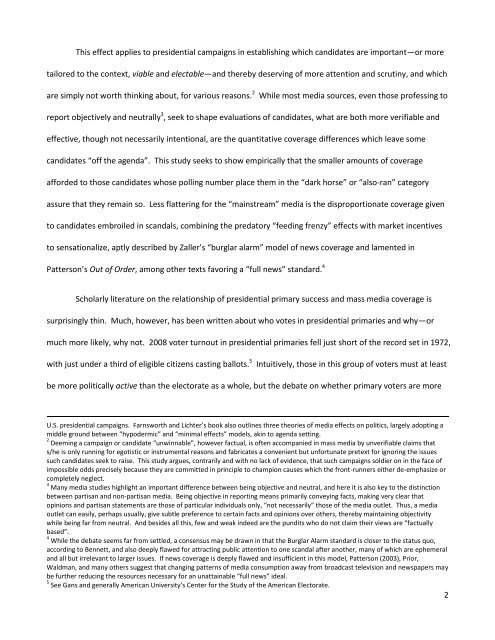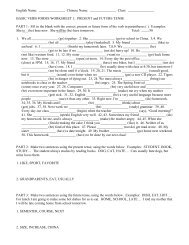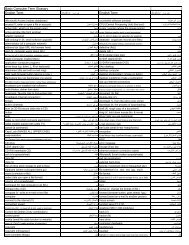Presidential Candidate Viability & Partisan Online ... - Omnifoo.info
Presidential Candidate Viability & Partisan Online ... - Omnifoo.info
Presidential Candidate Viability & Partisan Online ... - Omnifoo.info
Create successful ePaper yourself
Turn your PDF publications into a flip-book with our unique Google optimized e-Paper software.
This effect applies to presidential campaigns in establishing which candidates are important—or more<br />
tailored to the context, viable and electable—and thereby deserving of more attention and scrutiny, and which<br />
are simply not worth thinking about, for various reasons. 2<br />
While most media sources, even those professing to<br />
report objectively and neutrally 3 , seek to shape evaluations of candidates, what are both more verifiable and<br />
effective, though not necessarily intentional, are the quantitative coverage differences which leave some<br />
candidates “off the agenda”. This study seeks to show empirically that the smaller amounts of coverage<br />
afforded to those candidates whose polling number place them in the “dark horse” or “also-ran” category<br />
assure that they remain so. Less flattering for the “mainstream” media is the disproportionate coverage given<br />
to candidates embroiled in scandals, combining the predatory “feeding frenzy” effects with market incentives<br />
to sensationalize, aptly described by Zaller’s “burglar alarm” model of news coverage and lamented in<br />
Patterson’s Out of Order, among other texts favoring a “full news” standard. 4<br />
Scholarly literature on the relationship of presidential primary success and mass media coverage is<br />
surprisingly thin. Much, however, has been written about who votes in presidential primaries and why—or<br />
much more likely, why not. 2008 voter turnout in presidential primaries fell just short of the record set in 1972,<br />
with just under a third of eligible citizens casting ballots. 5<br />
Intuitively, those in this group of voters must at least<br />
be more politically active than the electorate as a whole, but the debate on whether primary voters are more<br />
U.S. presidential campaigns. Farnsworth and Lichter’s book also outlines three theories of media effects on politics, largely adopting a<br />
middle ground between “hypodermic” and “minimal effects” models, akin to agenda setting.<br />
2 Deeming a campaign or candidate “unwinnable”, however factual, is often accompanied in mass media by unverifiable claims that<br />
s/he is only running for egotistic or instrumental reasons and fabricates a convenient but unfortunate pretext for ignoring the issues<br />
such candidates seek to raise. This study argues, contrarily and with no lack of evidence, that such campaigns soldier on in the face of<br />
impossible odds precisely because they are committed in principle to champion causes which the front-runners either de-emphasize or<br />
completely neglect.<br />
3 Many media studies highlight an important difference between being objective and neutral, and here it is also key to the distinction<br />
between partisan and non-partisan media. Being objective in reporting means primarily conveying facts, making very clear that<br />
opinions and partisan statements are those of particular individuals only, “not necessarily” those of the media outlet. Thus, a media<br />
outlet can easily, perhaps usually, give subtle preference to certain facts and opinions over others, thereby maintaining objectivity<br />
while being far from neutral. And besides all this, few and weak indeed are the pundits who do not claim their views are “factually<br />
based”.<br />
4 While the debate seems far from settled, a consensus may be drawn in that the Burglar Alarm standard is closer to the status quo,<br />
according to Bennett, and also deeply flawed for attracting public attention to one scandal after another, many of which are ephemeral<br />
and all but irrelevant to larger issues. If news coverage is deeply flawed and insufficient in this model, Patterson (2003), Prior,<br />
Waldman, and many others suggest that changing patterns of media consumption away from broadcast television and newspapers may<br />
be further reducing the resources necessary for an unattainable “full news” ideal.<br />
5 See Gans and generally American University’s Center for the Study of the American Electorate.<br />
2






